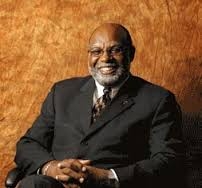You have /5 articles left.
Sign up for a free account or log in.

Maricopa Chancellor Rufus Glasper
Maricopa Community College District
In the last year, Maricopa Community College District has attracted a lot of attention.
The two-year system has faced court challenges from the state of Arizona over undocumented students and in-state tuition, as well as a complete defunding by state government.
These are just a couple of the recent challenges Chancellor Rufus Glasper has faced during his tenure as leader of the large two-year college district. Glasper, who has served as chancellor for 13 years and has worked at the district for a total of 30 years, announced last month that he will retire in February. However, he isn't straying too far from the community-college leadership role. Glasper will serve as president and chief executive officer of the League for Innovation in the Community College, a nonprofit organization that serves and advises two-year institutions.
Maricopa has changed dramatically from the colleges that enrolled 125,000 students in the mid-1980s, when Glasper started working there as an administrator, to a system that now enrolls about 265,000 students.
"We've seen some considerable growth," Glasper said. "However, during that same time we've seen an overall decline in state funding that's gone from a high in 1980 of about 29 percent, to the time I came in 1986, which was down to about 25 percent, to today, where it stands at zero," Glasper said.
In 2015, Maricopa received about $7.4 million in state funding. The district received $59.5 million from the state in 2009. This year Maricopa will get nothing.
Long-Term Solutions
Public perception of two-year colleges has shifted during Glasper's tenure, he said.
"Community colleges are viewed differently now than they were even 50 years ago, when we were established and began building the system. We were considered junior colleges then and now we're comprehensive community college systems. We've proven we're a large part of the economic development in our counties, states and country and we serve as a [postgraduate] institution," said Glasper. "So many individuals came to us during the recession with bachelor degrees and we put them through certifications and [associate degree] programs to get them jobs."
Glasper said it's been easy for the state's legislators to take what little dollars were available to the community colleges -- Pima Community College District also lost funding -- and insist they're instead funding the K-12 system, public universities and, in some cases, health care. Arizona's community colleges also receive funding through county taxes.
"They say we have the ability to increase tuition and property taxes, which we do, but we also know increasing property taxes and tuition in an economy coming off a recession is something not welcomed by anyone," he said. "I would like the community college to be perceived as a solution rather than a problem … There may be some future consequences. Not just today or tomorrow. The future consequence may be the growth in the economy may not be as robust. It may slow and there may be some longer-term consequences."
Maricopa established a corporate college a couple of years ago in part to help offset the loss of state funding. The college system has established partnerships with companies like Amazon, Ford Motor Company and Nissan as a way to provide noncredit and for-credit training to company employees.
These corporate partnerships have been spreading to other colleges across the country, and are well established at Central Piedmont College in North Carolina and the Lone Star College System in Texas, among others. Maricopa is a part of a larger corporate college consortium known as Global Corporate College, which has community college members across the country.
But Glasper cautions that corporate colleges can't immediately replace the long-term and permanent nature of state investments.
"Any initiative like a corporate college takes time to evolve into a new revenue base. The state funding from Arizona was permanent in nature and every year you were guaranteed a fixed dollar amount," he said. "With corporate college in Arizona and others across the country, it's based on contracts of three years or five years. It's based on projects or a service. So it's not as permanent, predictable or reliable as previous state funding and it will take many years for us to build stable funding from that particular piece."
Glasper acknowledges the need for a different way to build a stable funding source for the colleges. One could be Maricopa's Center for Entrepreneurial Innovation, which is connected to the corporate college.
The center essentially is a business incubator that provides the services, support and space to help start-up companies. However, Maricopa would have some ownership stake in new companies. Some years after these start-ups are established and turn a profit, then Maricopa receives its share of the profits, he said.
Immigration and Legal Battles
While the college system has been trying to hold onto state funding, Maricopa has faced another high-profile fight. For more than two years, the two-year college district has contested a lawsuit by the Arizona attorney general's office about allowing undocumented students under the federal Deferred Action for Childhood Arrivals (DACA) program to pay in-state tuition rates. That's due to a 2006 state law that banned public benefits to undocumented immigrants. The attorney general argued that since undocumented students were not in the country lawfully, the tuition policy -- which benefits Arizona residents -- violated the law.
Last year, a judge ruled that undocumented students are allowed to pay the lower rate, which prompted the Arizona Board of Regents to follow Maricopa's example and allow in-state tuition for DACA students at state universities. But the attorney general has taken the case to the Arizona Court of Appeals.
"We are still in the courts," Glasper said. "But a decision from the federal government would help clarify what is going on and that message could resonate with our community."
Maricopa currently has about 2,000 DACA students who are paying the in-state tuition rates. Prior to 2012, there were more than 10,000 undocumented students enrolled at the district who were paying a rate that was more than in-state tuition, but less than out-of-state prices, Glasper said.
Looking Forward
Glasper won't predict what will happen at Maricopa after he leaves. But he has been involved in an initiative called One Maricopa, which is looking at ways to better unite all 10 colleges in the system to provide a better experience for students.
Today, more than 60,000 Maricopa students move between one or more of the district's colleges within a three-year period, so the system is using the new initiative to reduce costs by not duplicating programs. Under One Maricopa, students will be able to complete their degrees at several colleges or wherever they need to complete their goals. So a student who lives near one Maricopa college but works near another can take courses at both colleges in the pursuit of their degree.
"One Maricopa is a philosophy and it is a strategy and an initiative," he said, "that keeps student success at the center of the kind of experience students would like to have and how we can do that with a single focus on student success as opposed to 10 separate foci."
Despite the challenges in recent years, there's no need for anyone within the system to panic, Glasper said.
"We do need to recognize the community college is a vital asset in this community," he said.








